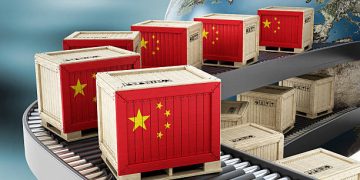Tariffs imposed by the United States on a range of Chinese products are expected to stay at 30% until late 2025, according to a recent Bloomberg survey of 22 respondents, including fund managers, banks, and research firms across Asia, Europe, and the U.S.
While current rates are lower than earlier peaks, Bloomberg Economics estimates they remain high enough to significantly reduce Chinese exports to the U.S. in the medium term.
Conducted on Wednesday and Thursday, the survey indicates limited optimism for major tariff rollbacks in the near term. Many analysts anticipate trade negotiations will likely lead to only modest adjustments, with few expecting substantial policy shifts before the 2026 U.S. midterm elections.
“There is not enough time for the relative positions to change materially,” said Kelly Chen, economist at DNB Bank.
The outlook becomes more varied when projecting beyond six months. While seven respondents foresee tariffs falling below 30%, six expect further increases. If a final agreement is reached, the median forecast sees the rate lowering to 20%.
A 90-day mutual tariff reduction period began Wednesday, as both sides temporarily adjusted duties to ease trade tensions. Despite this, most respondents believe tariffs introduced in the earlier policy rounds will likely remain, with Bloomberg Economics estimating the average of those duties at 12%.
These trade measures are among the most closely watched variables influencing global markets this year. Analysts expect Chinese financial markets to remain relatively stable, with moderate movement due to continued policy and economic uncertainty.
The yuan is projected to hover around 7.2 per dollar by the end of 2025, with limited speculation of significant currency shifts. Some respondents suggest that positive tariff developments could lessen the need for additional policy easing.
Robert Gilhooly, senior emerging markets economist at Aberdeen Investments, predicts tariffs may eventually stabilize around 50%, noting that any economic slowdown could prompt future currency adjustments.
Chinese stock indices, such as the CSI 300, are forecast to rise slightly, supported by early export activity, structural changes, and technology sector developments. Meanwhile, the 10-year government bond yield is expected to remain near 1.7%, reflecting muted expectations for further easing.
Economic indicators scheduled for release Monday are expected to show China’s industrial output grew 5.9% year-on-year in April, a slowdown from March’s 7.7% pace. Retail sales are forecast to increase by 6%, while fixed-asset investment growth is projected to hold steady at 4.3%.
Analysts believe recent trade measures may be reflected in April’s economic data, particularly in industrial output and export figures, as manufacturers adjusted to shifting demand and pricing conditions.
#TradePolicy #USChinaTrade #TariffsUpdate #GlobalEconomy #SupplyChainNews

















